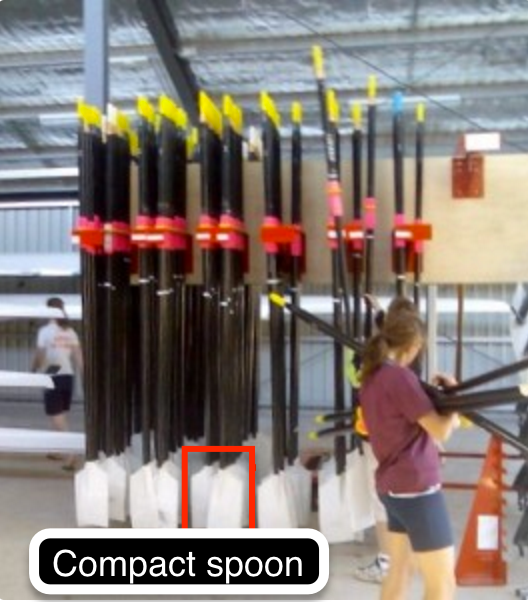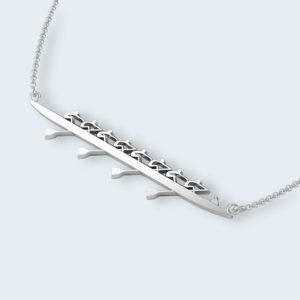A question I answered on Quora.


The principal oar manufacturers are Concept2, Croker, Dreher, Braca, Swift, WinTech. There are others. The big names (first 3) develop new designs regularly. It’s worth trying out oars to find which suit you best. Do several outings and make the length and inboard identical to your current pair so the comparison is fair.
Blade choice is very personal – I’ve never seen a speed test that proves one design is faster. BUT there are some variations in design which are worth considering before purchase.
1 – Handle diameter and covering. Some like smooth, wood, others like rubber or textured. Sweep oar handles are different from sculling. It’s important to have a handle size that suits your hand size. Most manufacturers have small, medium and large. Croker do a range of sculling grips with thicker rubber in differing colours to reflect hand size so you don’t have to replace the handles, just the rubber grip. I wrote this ebook how to change your scull handle grips.
2 – Shaft stiffness. The amount of carbon fibre in the shaft affects the longitudinal deflection of the shaft when under tension (the oar is under the water and loaded with pressure). Strong men can manage a stiff shaft, women, children and masters (or people with back injuries) prefer softer shafts with less stiffness. Most oar manufacturers make soft, medium and stiff shafts. If you’re an Olympian man – pick stiff. If you’re a club rower, medium and for children, lightweight women and masters – go soft.
3 – Spoon design. The surface area of the spoon and the shape affects the load which can be applied. A larger surface area is generally a higher possible load. BUT the ability (technical skill) of the athlete also affects the load. If you cannot put all the oar under the water before loading (pushing your legs), then a larger spoon which is partially covered with water may be more effective than a smaller spoon. The classic shapes are coffin, Macon, cleaver, round or big blade. The first two are little used since 1990s. Cleavers may have a smooth face or a ridge across the front of the spoon. Big blades look like a square with the corners rounded off and are deeper than cleavers. The ridge affects how the oar grips the water and how the water flows across the face of the spoon.
4 – The angle of the spoon where it connects with the shaft is the cant. This affects how the oar sits in the water when at rest and not loaded. Ideally the top side of the spoon is parallel with the water surface. Some oar designs are buoyant and sit partly above the water surface – this requires the athlete to hold the oar under the water during the power phase and is a matter of skill and personal preference.
5 – How each component is assembled. The handle joins the shaft which joins the spoon. Most manufacturers use epoxy glue to join them – this can’t be un-glued. An important consideration is whether the shaft inserts into the spoon or the reverse. The join ideally should be aerodynamic and if it has a bulge, this can affect how efficiently the oar works.
If the pitch of the spoon goes out of alignment, the only solution is to re-sleeve the oar or shave down the sleeve. Dreher used hot-melt glue which can be melted and pitch adjusted. (check if they still do this).
6 – Length adjustment system. There are several systems – some have screws in the handle, others have clamps in the shaft. Most oars are adjustable length. All suffer from accumulated grime in the join between shaft and handle and this can lead to difficulties lengthening and shortening. The precision of fit between the components affects the long term adjustability. Ask existing users to try to adjust their oars and see how easy older oars move.
7 – Weight in the hand. The oars pivot around the oarlock / swivel and the mass of the oar plus the balance of mass through the length of the oar affects how “heavy” they feel in your hand. Beginners tend to like more weight int eh hand so they have better awareness of their movements affecting the oar height. Lighter oars can be ‘blown’ about by the wind and require a more skilful user to overcome this tendency. Generally rowers like lighter oars as you have to carry the mass of your equipment down the race course. Weight in the hand can be balanced without adding mass to the oars themselves.
8 – Painting your oars. Most clubs have a preferred colour scheme – there are tips which help preserve your paint and an ebook I wrote about how to paint oars How to paint your Oars and Sculls When boating or landing, always turn your oars over so the tips touch the dock pontoon – then the paint on the back gets fewer scratches. Another important consideration is how you hang your oars when not in use. A smart design frame by Space Saver Rowing allows each oar to be removed independently. Horizontal racking takes a lot more space than vertical.








This Post Has One Comment
Also check out the Row2K blade comparator tool which overlays two spoon designs so you can see which is larger and the shape differences http://www.row2k.com/features/980/row2k-Blade-Comparator/